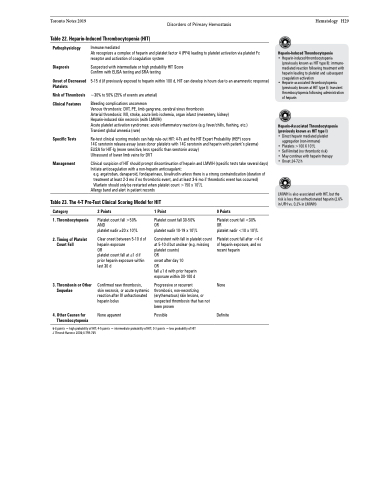Page 569 - TNFlipTest
P. 569
Toronto Notes 2019 Disorders of Primary Hemostasis Table 22. Heparin-Induced Thrombocytopenia (HIT)
Hematology H29
Heparin-Induced Thrombocytopenia
• Heparin-induced thrombocytopenia (previously known as HIT type II): immune- mediated reaction following treatment with heparin leading to platelet and subsequent coagulation activation
• Heparin-associated thrombocytopenia (previously known at HIT type I): transient thrombocytopenia following administration of heparin
Heparin-Associated Thrombocytopenia (previously known as HIT type I)
• Direct heparin mediated platelet
aggregation (non-immune)
• Platelets >100 X 109/L
• Self-limited (no thrombotic risk)
• May continue with heparin therapy • Onset 24-72 h
LMWH is also associated with HIT, but the risk is less than unfractionated heparin (2.6% in UFH vs. 0.2% in LMWH)
Pathophysiology
Diagnosis
Onset of Decreased Platelets
Risk of Thrombosis Clinical Features
Specific Tests
Management
Immune mediated
Ab recognizes a complex of heparin and platelet factor 4 (PF4) leading to platelet activation via platelet Fc receptor and activation of coagulation system
Suspected with intermediate or high probability HIT Score Confirm with ELISA testing and SRA testing
5-15 d (if previously exposed to heparin within 100 d, HIT can develop in hours due to an anamnestic response)
~30% to 50% (25% of events are arterial)
Bleeding complications uncommon
Venous thrombosis: DVT, PE, limb gangrene, cerebral sinus thrombosis
Arterial thrombosis: MI, stroke, acute limb ischemia, organ infarct (mesentery, kidney) Heparin-induced skin necrosis (with LMWH)
Acute platelet activation syndromes: acute inflammatory reactions (e.g. fever/chills, flushing, etc.) Transient global amnesia (rare)
Re-test clinical scoring models can help rule-out HIT: 4-Ts and the HIT Expert Probability (HEP) score
14C serotonin release assay (uses donor platelets with 14C serotonin and heparin with patient’s plasma) ELISA for HIT-Ig (more sensitive, less specific than serotonin assay)
Ultrasound of lower limb veins for DVT
Clinical suspicion of HIT should prompt discontinuation of heparin and LMWH (specific tests take several days) Initiate anticoagulation with a non-heparin anticoagulant:
e.g. argatroban, danaparoid, fondaparinaux, bivalirudin unless there is a strong contraindication (duration of treatment at least 2-3 mo if no thrombotic event, and at least 3-6 mo if thrombotic event has occurred) Warfarin should only be restarted when platelet count >150 x 109/L
Allergy band and alert in patient records
Table 23. The 4-T Pre-Test Clinical Scoring Model for HIT
Category
1. Thrombocytopenia
2. Timing of Platelet Count Fall
3. Thrombosis or Other Sequelae
4. Other Causes for Thrombocytopenia
2 Points
Platelet count fall >50% AND
platelet nadir ≥20 x 109/L
Clear onset between 5-10 d of heparin exposure
OR
platelet count fall at ≤1 d if prior heparin exposure within last 30 d
Confirmed new thrombosis, skin necrosis, or acute systemic reaction after IV unfractionated heparin bolus
None apparent
1 Point
Platelet count fall 30-50% OR
platelet nadir 10-19 x 109/L
Consistent with fall in platelet count at 5-10 d but unclear (e.g. missing platelet counts)
OR
onset after day 10
OR
fall ≤1 d with prior heparin exposure within 30-100 d
Progressive or recurrent thrombosis, non-necrotizing (erythematous) skin lesions, or suspected thrombosis that has not been proven
Possible
0 Points
Platelet count fall <30% OR
platelet nadir <10 x 109/L
Platelet count fall after <4 d of heparin exposure, and no recent heparin
None
Definite
6-8 points = high probability of HIT; 4-5 points = intermediate probability of HIT; 0-3 points = low probability of HIT J Thromb Haemos 2006;4:759-765


